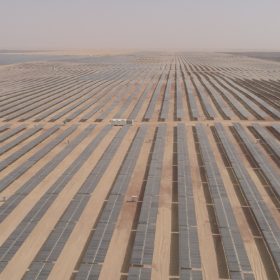
U.S. scientists have developed a model to predict the performance of bifacial PV at project level. Their results show that when improved temperature sensitivity is properly taken into account, the advantage of bifacial modules could be even larger than previously thought. And for upcoming module technologies like heterojunction in particular, it could mean bifacial is viable in even more parts of the globe.
With manufacturers making a rapid move toward bifacial modules, the downstream industry has been hard at work over the past year or two to integrate the additional factors affecting bifacial performance into their models. Since these models often play a vital role in a project’s success, this is important work.
When it comes to modeling bifacial energy yield, much of the debate has centered around how to accurately integrate the albedo of the surface below a module, and the non-uniformity of the light hitting the rear side, into models. According to a new study led by scientists at Purdue University in the United States, the improved temperature sensitivity of bifacial modules is a factor overlooked in some modeling and one which can drastically change the performance picture.
“Our analysis finds bifacial technology to be economically viable in many more parts of the world compared to the previous predictions by temperature-independent models,” says Muhammad Ashraf Alam, professor of electrical and computer engineering at Purdue University. “The competitive advantage of bifacial farms arises in equal measures from two factors: improved temperature sensitivity and height-enhanced albedo light collections.”
The researchers presented the model in “Temperature-dependent energy gain of bifacial PV farms: A global perspective,” which was recently published in Applied Energy. The group sought to integrate temperature-dependent efficiency data with existing model parameters such as irradiance and light collection, and found that including the details on temperature typically led to changes of 10% to 15% to modeled energy yield and levelized cost of energy values.
Bifacial future
The paper also found that for upcoming cell/module technologies such as heterojunction, the advantage is even clearer thanks to the technology’s better temperature coefficient. The scientists estimate that the bifacial gain for a silicon heterojunction module installed in a ‘hot’ location close to the equator could reach up to 12%, and an impressive 45% at latitudes of 30 degrees and above.
The group says that its model could change the understanding of bifacial module performance, demonstrating economic viability for the technology in many more locations than previously thought. And it further hopes to stay ahead of the curve by making models that can account for heterojunction and other upcoming module technologies.
“The analysis presented in this paper will allow us to realistically assess location-specific relative advantage and economic viability of the next generation bifacial solar farms,” said the researchers.
Lắp đặt điện mặt trời Khải Minh Tech
https://ift.tt/2X7bF6x
0906633505
info.khaiminhtech@gmail.com
80/39 Trần Quang Diệu, Phường 14, Quận 3
Lắp đặt điện mặt trời Khải Minh Tech
https://ift.tt/2ZH4TRU
Không có nhận xét nào:
Đăng nhận xét